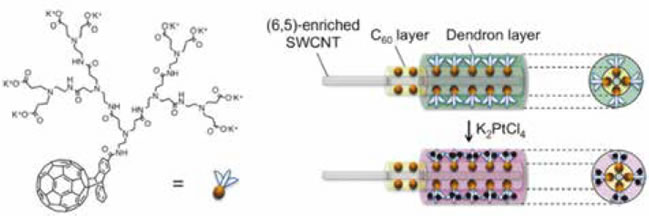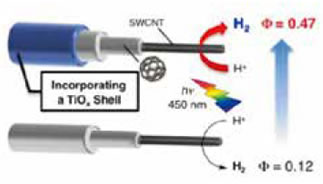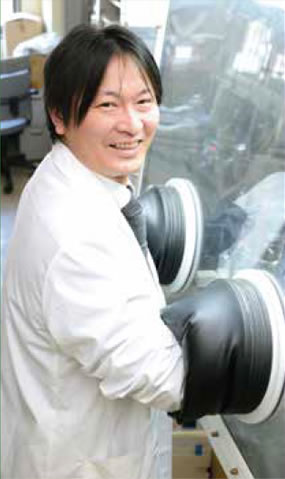Research Area : Advanced Organic Materials
The SWCNT photocatalyst for hydrogen production from water upon photoexcitation of (8,3) SWCNT at 680-nm light
Single-walled carbon nanotubes (SWCNTs) are potentially strong optical absorbers with tunable absorption bands depending on their chiral indices (n, m). Their application for solar energy conversion is difficult because of the large binding energy (>100 meV) of electron-hole pairs, known as excitons, produced by optical absorption. Recent development of photovoltaic devices based on SWCNTs as light-absorbing components have shown that the creation of heterojunctions by pairing chirality-controlled SWCNTs with C60 is the key for high power conversion efficiency. In contrast to thin film devices, photocatalytic reactions in a dispersion/solution system triggered by the photoexcitation of SWCNTs have never been reported due to the difficulty of constructing a well-ordered surface on SWCNTs. Here, we show a clear-cut example of a SWCNT photocatalyst producing H2 from water. Self-organization of a fullerodendron on the SWCNT core produces water-dispersible coaxial nanowires possessing SWCNT/C60 heterojunctions, of which a dendron shell can act as support of a co-catalyst for H2 evolution. Because the band offset between the LUMO levels (8, 3) SWCNT and C60 satisfactorily exceeds the exciton binding energy to allow efficient exciton dissociation, the (8, 3) SWCNT fullerodendron coaxial photocatalyst shows H2-evolving activity (QY = 0.015) upon 680-nm illumination.

Incorporating a TiOx shell in single-walled carbon nanotube/fullerodendron coaxial nanowires: increasing the photocatalytic evolution of H2 from water under irradiation with visible light
A custom-tailored single-walled carbon nanotube (SWCNT) photocatalyst with an electron-extracting TiOx shell, i.e., a SWCNT/fullerodendron/TiOx coaxial nanowire, has been fabricated. Due to the presence of the TiOx shell, the SWCNT/fullerodendron/TiOx coaxial nanowire shows enhanced photocatalytic activity (Φ = 0.47) for the evolution of hydrogen from water under irradiation with visible light (λ = 450 nm).

Ligand Exchange Reaction of (Me4N)4[Cd10S4(SPh)16] with Diphenyl Diselenide
The reaction of (Me4N)4[Cd10S4(SPh)16] (with diphenyl diselenide in propionitrile afforded a molecular cluster, (Me4N)4[Cd10S4(SPh)16], the structure of which was determined by X-ray crystallography. Ligand exchange proceeded in a heterogeneous reaction system, and the use of a less polar solvent appeared to be crucial for the synthesis of (Me4N)4[Cd10S4(SPh)16] to prevent degradation of the Cd10S4(SPh)16 cluster core.




